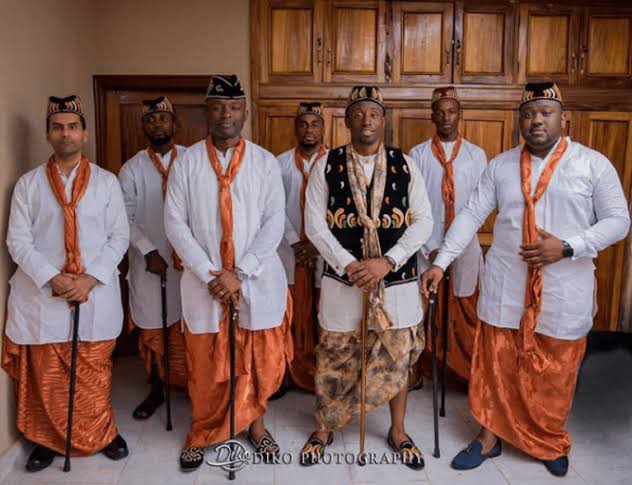The entire fuss about weddings is usually centred around the bride. The wedding planners and even parents are more concerned about the bride’s outfits and appearance. More often than we realise, the grooms are sometimes left out of the frenzy and tend to just show up on the day. So many brides unconsciously control every part of the planning phase, when they make decisions on everything pertaining to the wedding including their groom’s outfits and colours.
The grooms hardly complain and are usually just happy to go with the flow and let the brides-to-be decide their outfits and everything else while they soak in the euphoria of the moment. A few grooms do take the time to be involved and actually interested in how they and their guys would arrive in grand style on the day.
Drawing inspiration from the traditional and contemporary styles of the Efik and Ibibio people of Nigeria, grooms can create a regal wedding look by focusing on key elements. While both cultures, who share a similar heritage, feature the “Usobo” (wrapper) and elaborate attire, Efik tradition leans towards more ornate, European-influenced styling, while Ibibio attire is elegant and a little more understated.
Efik groom’s royal attire
The Efik groom’s ensemble is known for its regal and commanding presence. The complete look is reminiscent of European colonial-era fashion fused with rich Nigerian culture.
Key components:
- Wrapper (Usobo): A ceremonial wrapper tied around the waist, typically made from luxurious materials like silk, damask, or velvet. The fabric is often richly colored and can be paired with plain white shorts underneath.
- Shirt: A long-sleeved, intricately embroidered shirt made from high-quality cotton or lace. The embroidery often complements the bride’s attire.
- Jacket (Akwa Iban Isong): A stylish, embellished jacket worn over the shirt, adding a layer of sophistication.
- Headwear: A wide-brimmed hat or top hat, which adds to the regal aesthetic.
- Neck scarf (Okpompom): A decorative scarf hung around the neck.
- Footwear: Perfectly polished black leather shoes.
- Accessories:
- Beads: Multiple strands of coral beads are worn around the neck and wrists to symbolize status, wealth, and cultural pride.
- Walking Stick: A polished cane is often carried as a symbol of authority and prestige.
- Ceremonial Staff or Sword: Some grooms may carry a ceremonial weapon, symbolizing strength and leadership.
Ibibio groom’s refined attire
The Ibibio groom’s look is traditionally more understated than the Efik style, emphasizing dignity and cultural pride. It often features a flowing, embroidered top rather than a tailored jacket.
Key components:
- Wrapper (Usobo): A vibrantly colored or patterned wrapper, tied at the waist. It can be made from a range of rich fabrics like silk or damask.
- Shirt (Etibo or Isiagu): A long, flowing, and distinctively embroidered shirt. The embroidery reflects traditional Ibibio motifs and can include beaded embellishments or sequins.
- Headwear (Knitted Cap): A simple, knitted cap or a conical hat called an “Okpu Agwu” is worn, often decorated with feathers.
- Footwear: Can range from simple leather sandals to polished black shoes, depending on preference.
- Accessories:
- Beads: Coral beads are used more sparingly than in Efik attire, often to signify beauty and ancestral blessings.
- Walking Stick: A walking stick is also a common accessory.
- Hand Fan: Some grooms carry a hand fan with ancestral or animal symbols.
Modern styling inspiration
Contemporary grooms often take inspiration from both cultures, fusing them to create a unique and personalized look.
- Bold color choices: Incorporate modern hues while respecting the traditional color palettes. For example, a deep burgundy or royal blue velvet Usobo can make a powerful statement.
- Monochromatic look: Create a sleek, modern aesthetic by matching the shirt and wrapper in a single color, with intricate embroidery as the centerpiece.
- Coordinating with the bride: Ensure the groom’s embroidery patterns or beadwork complement those on the bride’s attire for a cohesive look.
- Accessorize with intention: Choose accessories that reflect your personal style. For a less formal look, opt for a simpler cap instead of a top hat.
- Add a touch of bling: Incorporate tasteful sequins or beading on the shirt to add flair without being overly ornate.
- Choose the right fabric: Consider the venue and season when selecting fabric. Lighter cottons are suitable for warmer weather, while silk and velvet offer a more
The Ibibio groom, from Akwa Ibom State in southern Nigeria
Traditional Efik Attire: Usobo, Onyonyo
We have some inspiring photos and moments from our Efik/Ibibio grooms below, for the grooms-to-be who are fully involved in the choice of outfits for the day and crave some inspiration.








Leave a Reply